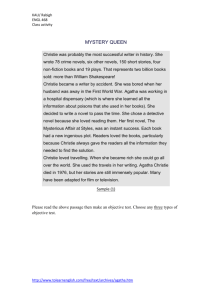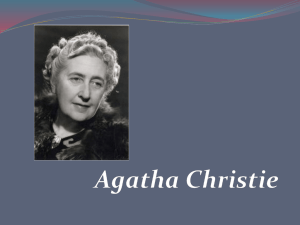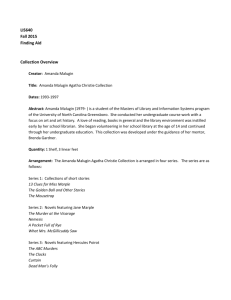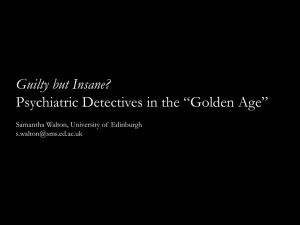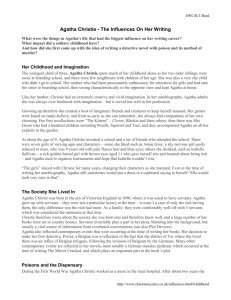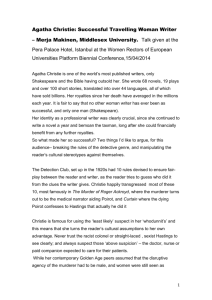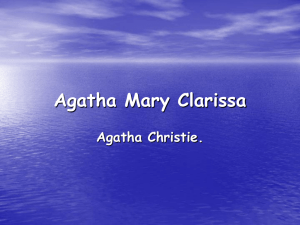She was born in 1890 in Torquay, Devon, England
advertisement
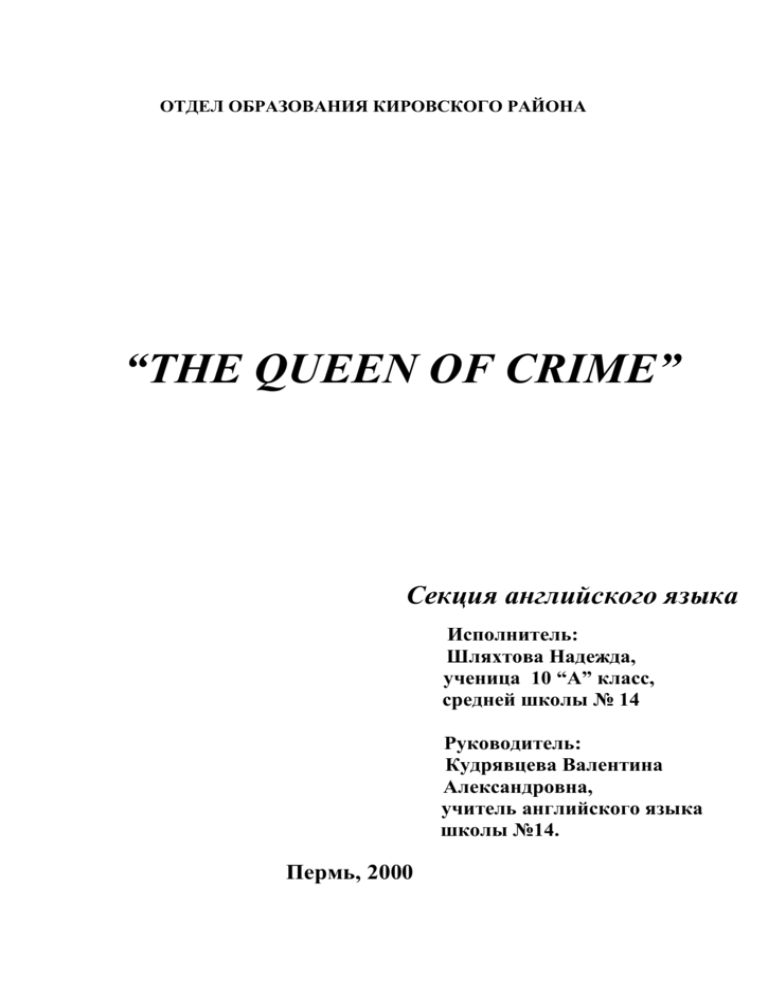
ОТДЕЛ ОБРАЗОВАНИЯ КИРОВСКОГО РАЙОНА “THE QUEEN OF CRIME” Секция английского языка Исполнитель: Шляхтова Надежда, ученица 10 “А” класс, средней школы № 14 Руководитель: Кудрявцева Валентина Александровна, учитель английского языка школы №14. Пермь, 2000 CONTENTS: INTRODUCTION. ……………………………………………………1 1. AGATHA CHRISTIE’S BIOGRAPHY. …………………………2 2. THE MAIN CHARACTERS OF HER DETECTIVES. ………….4 3. THE REASONS OF GREAT POPULARITY. …………………. 6 4. CONCLUSIONS. ………………………………………………… 8 LITERATURE. ……………………………………………………… 9 INTRODUCTION A lot of books are written about Agatha Christie’s life. She is considered to be the queen of detective stories. She has conquered the world by her novels. She wrote 78 crime novels, six romantic novels, 150 short stories and 19 plays. Her books have been translated into 103 languages. The number of copies of her books is about 300 mln. Why has she succeeded with her style? Why was she so popular? To find the answer to these questions became the aim of my work. I study at humanitarian class and my interest to literature is great. Besides, English is my favourite subject. I find this theme actual, because the work on it will help me to master my English and discover a new page in world literature. In my research work I’ll describe Agatha Christie’s biography, analyze her creation and the peculiarities of her language and find out the reasons of her great popularity. I’ll also represent the results of the questionnaire of my classmates concerning Agatha Christie’s works and express my attitude to her novels. I have done a lot preparing this work. First of all, I studied the biography of the writer, read some of her novels in the original, analyzed her works and interwied my classmates on the reasons of Agatha Christie’s popularity. It was very interesting and useful to work on the given theme. This written work can be used at Literature and English lessons and at extra curricular activities, devoted to great personalities. I’m sure it will help to broaden the students’ outlook. AGATHA CHRISTIE’S BIOGRAPHY Agatha Mary Clarissa Miller was born in 1890 in Torquay, Devon, England. Agatha was educated at home by her parents and then attended finishing school in Paris, where she showed particular talent as a singer and pianist. She considered a musical career, but eventually decided that her shyness in public would be an insurmountable barrier to a concert career. In 1913,Agatha met Archibald Christie, a young army officer, and they were married on 24 December, 1914.They were separated for most of the war, and Agatha continued to live at Ashfield while she volunteered as a nurse and pharmaceutical dispenser at local hospitals. Her knowledge of poisons and fascination with them developed there. After the war, Archie Christie went into business in London, while Agatha remained at home with their daughter Rosalind, born in 1919. In 1926, Christie’s work first gained major recognition with the publication of “The Murder of Roger Ackroyd”. In the same year, the death of her mother coupled with sever marital problems led to a nervous breakdown, which climaxed with Agatha’s much-publicized disappearance for ten days in December 1926. It happened when her husband wanted a divorce so that he could marry another woman. Agatha told her secretary that she was going for a motor drive, that she wouldn’t return home that night, and that she wouldn’t “ring up” when she reached her destination. The next day the police found her car in a ditch with its lights on. There was no trace of Agatha. The police became suspicious. Was the husband hiding anything? Did he decide to get rid of his wife? A nation-wide search for the missing writer was started. Newspapers published wild stories about her disappearance-that she had been murdered, that she had run away with a secret lover… Eleven days later the mystery was solved. Agatha Christie was found alive in a health spa in Yorkshire… But to this day, nobody knows what really happened in December, 1926.Agatha Christie loved travelling. When she became rich, she could go all over the world. She used her travels in her writing. Many of her later books have exotic titles like “Death on the Nile” and “Murder on the Orient Express” Agatha and Archibald divorced in 1928 (he died in 1962). When she was around 40 years old she went on a holiday and visited e.g. Iraq where she met archaeologist Max Mallowan, who was14 years younger than she. They married in 1930 and Agatha Christie became Agatha Christie Mallowan. The Mallowans divided their time between several homes in England and archeological expeditions in the Middle East. During World War the second, Max Mallowan served as an intelligence liaison officer in North Africa, while Agatha remained in London and worked once again as a volunteer at a dispensary. She often assisted her husband on excavations, e.g. in Iraq and Syria. After the war, the Mallowans resumed their trips to the Middle East, which continued for almost a decade. During the early 1950s, Christie’s second career, as a playwright, reached its peak with the production of “The Mousetrap” and “Witness for the Prosecution” in London in 1952 and 1953. After a leg injury in 1971, Christie’s health began to deteriorate, and both the quality and frequency of her books declined. Her last formal public appearance was in 1974 at the opening of the film “Murder on the Orient Express”, which was attended by Queen Elizabeth and members of the royal family. Agatha Christie was the president of the Detection Club. She became Dame Agatha in 1971. She died in 1976, but her stories are still immensely popular. Many have been adapted for film or television. When someone sits down to watch or read an Agatha Christie, they always have the same challenge: try to find out that the murderer is before the detective does! THE MAIN CHARACTERS OF HER DETECTIVES. Now I’d like to tell you about Agatha Christie’s stories. Her first novel, “The Mysterious Affair at Styles” was an instant success. Like many of Christie’s stories, it has one murder victim and many possible murderers. Emily Inglethorp is a rich old lady. When she is murdered, all the people with motives to kill her have alibis. So who did it? The police have no idea, but the Belgian detective Hercule Poirot finds the murderer. Hercule Poirot became one of the most popular private detectives since Sherlock Holmes. He is the hero of 43 Christie’s crime stories. Poirot has many characteristics which have made him a legend all over the world-the odd moustache, the egg-shaped face and his high opinion of himself. He will though most likely be best remembered for his ability to solve complicated mysteries with the help of his little grey cells. In that area he was a worthy successor of Arthur Conan Doyle’s Sherlock Holmes. Poirot is probably Agatha Christie’s best-known character – and he has of course often appeared in films, portrayed by various actors. Albert Finney played him in “The Murder on the Orient Express” and Peter Ustinov has also played Poirot in many movies, such as “Death on the Nile” and “Evil Under the Sun”. Many fans of Poirot do though agree that David Suchet (from the Poirot TV series) is most likely the actor who has succeeded best in portraying the famous detective. Hercule Poirot has even become so famous as an independent character that Anne Hart, a librarian in Newfoundland has written his biography ”The Life and Times of Hercule Poirot”. Anne Hart has also written Jane Marple’s biography. But Poirot was not always alone- in Christie’s early Poirot stories Captain Arthur Hastings tried to help him – but always seemed to miss the clues that were of importance. Of course, Captain Hastings is not as intelligent as Poirot In Poirot’s later adventures Hastings was not such a frequent guest but Poirot also had other friends such as Ariadne Oliver (the mystery writer) and Detective Inspector (Chief Inspector) Japp. Austin Trevor played Hercule Poirot in three movies in the early thirties (“Alibi” ”Black Coffee” “Lord Egware Dies). Tony Randall played Poirot in one picture in 1965, “The Alphabet Murders”. In 1974 another unusual Poirot appeared – Albert Finney – in the Academy Award winning movie “The Murder on the Orient Express», where the some of the suspects were played by world famous actors – Ingrid Bergman, Sean Connery, John Gielgud and Lauren Bacall. So, during the Second World War, she wrote a book called “Curtain», in which Poirot dies. But she did not publish it until 1975. Charles Osborne published a new Poirot book in 1998. Miss Jane Marple is another Agatha Christie’s creation. “Murder at the Vicarage” was published in 1930, but I cannot remember where, when or how I wrote it, why I came to write it, or even what suggested to me that I should select a new character – Miss Marple – to act as the sleuth in the story. Certainly at the time I had no intention of continuing her for the rest of my life. I did not know that she was to become a rival of Hercule Poirot. “- Wrote Agatha in her biography. Miss Marple was the star of twelve Christie books, “ The Murder at the Vicarage” “The Body in the Library” “The Moving Finger” “A Murder is Announced” “They Do It with Mirrors” “A Pocketful of Rye” “4.50 from Paddington” “The Mirror Crack’d from Side to Side” “A Caribbean Mystery” “ At Bertram’s Hotel” “Nemesis” and “ Sleeping Murder”. She also appeared in 20 short stories. She was already an old lady in the first book, as Agatha herself describes in her Autobiography: “Miss Marple was born at the age of sixty-five to seventy- which, as with Poirot, proved most unfortunate, because she was going to have to last a long time in my life. If I had had any second sight, I would have provided myself with a precocious schoolboy as my first detective; then he could have grown old with me.” Marple is an English spinster and lives in the English village of St. Mary Mead and is not likely detective but always succeeds where the police have failed. Instead of using a magnifying glass looking for clues she uses her instinct and knowledge of human nature. Margaret Rutherford played Miss Marple in a few movies in the sixties but Joan Hickson is the most famous Miss Marple and appeared in TV series and TV movies, but she also played other roles in other Agatha Christie movies. Helen Hayes and “Murder She Wrote’s” Angela Lansbury have also portrayed Marple. THE REASONS OF GREAT POPULARITY Agatha Christie represents the “light genre” in the twentieth century of English Literature. A great master of detective story, she thrilled the world. Agatha Christie has conquered the world, and the critics are puzzled. Part of her charm for her readers is the setting of many of her mysteries in a context of English village life, but her stories appeal to people in countries remote from England who know nothing about England and have no interest in the English. It will be said, of course, that her appeal is merely that of the puzzle, but there were plenty of other ingenious puzzlers in this period, and they are forgotten. Why has she succeeded with her flat style (even her warmest admires concede this) and her cardboard characters? Perhaps the answer is that the characters (in the books, rather than the dramatization of them) are not cardboard - or not all of them. There is something deeply appealing about Christie’s stories, which has not yet been adequately analyzed. Conan Doyle created the genre with “Sherlock Holmes”, establishing it on a basis of English comedy, as unclassifiable as the “Alice” books, or the “Pooh” of A. A. Milne. But strange and terrible things in the “Holmes” stories remain strange and terrible, whereas Agatha Christie assimilates everything to what would seem on the face of it a self-stultifying literary form: the reassuring tragedy. Agatha Christie found it hard to be specific about just how she created the plots, which consistently baffle her readers. She readily acknowledged her debt to Conan Doyle. The author’s first detective novel “The Mysterious Affair at Styles” was written in 1915 and published in 1920 – seven years before the last Sherlock Holmes short story collection appeared in book form. She produced a mystery novel or a short-story collection at the rate of at least one a year since 1920, and one might imagine that the early books would be somewhat dated by this point. Surprisingly enough, they are not. A career, which exceeds forty-five years in length, is remarkable in any field, but is especially noteworthy in the field of so-called “popular” literature, for it would seem that people’s tastes would change radically in that span of time. Although A.Christie’s mysteries remain remarkably consistent in their appeal to readers, it is possible to notice some changes or advances in the manner and style of mystery writing from 1920 to the present day. As the mystery story as a form becomes more mature and sophisticated, so do its readers. They can keep in their heads as many details as the detective can. So, diagrams, maps and parables have been out of vogue since the 1930s. The two devices, which the author has used over and over Again are the nursery rhyme as an organizing theme and spiritualism as a cover for a perfectly straightforward crime. Agatha Christie has evidently found in nursery rhymes an inspiration which permits her to develop plots with built-in suspense: the reader knows that the murderer is following the rhyme, and he knows in general terms what will come next (if he can remember the rhyme), but he is kept guessing as to how the author and the murderer will make the crime fit the rhyme. The most famous example of a nursery rhyme followed to the last detail is “Ten Little Niggers.” Dame Agatha Christie made more profit out of murder than any woman since Lucrezia Borgia. One estimate of her total earnings from more than a half-century of writing is $ 20 million. Her characters were: doctors, lawyers, army officers, and clergymen. Her stalking grounds were usually genteel English houses, and she rarely strayed. In a Christie murder mystery, neatness not only counts, it is everything. As the genre’s undisputed queen of the maze, she laid her tantalizing plots so precisely and dropped her false leads so cunningly that few – if any – readers could guess the identity of the villain. Each Agatha Christie’s book had a new and ingenious plot. Readers loved the books, particularly because Christie always gave the readers all the information they needed to find the solution. Agatha Christie’s talents seem most aptly used in the detective story – her talents are analytical, wryly humorous, and penetrating in telling a tightly knit story, and her romance always seems less convincing. Perhaps this is due to the fact that detective story and novel are essentially a cerebral form, thanks to their conventions and confines of plot and the sort of mind who likes well-made plots is not likely to go in for formless romance and affection. CONCLUSIONS Summing it up and making a conclusion I should say about my attitude to the creation of a prominent English writer Agatha Christie. Working at this report, I’ve read some of her detective stories in Russian and in the original. Her plots are very interesting and exciting. Her every story has different plots. Besides, it is very interesting to guess who the murderer is. Her stories are very intricate. Her language is concrete and laconic. There are many interesting turns of speech in her stories. Her language keeps variety and peculiarities of everyday English oral and writing speech. The writer can intrigue her readers. She doesn’t let go our attention till the story ends. The end of any story is always unexpected. Agatha Christie belongs to the writers for whom keen observation and great memory play more important role than for other writers. All victims in her novels are killed with the poison. There is no violence description of murders in her stories. That is why her novels are easy for reading. Agatha was the best writer of her period. She is truthfully called ”The Queen of Detectives”. She is really honoured this title. Now I’d like to represent you my analysis of the questionnaire, which I’ve done among my classmates. The questions were following: 1.Do you like to read detective stories? 2.Do you like to read Agatha Christie’s detectives? 3.What Agatha Christie’s detectives have you read? 4.What characters made a great impression on you? 5.What are the reasons of Agatha Christie’s popularity? 6.Are her books or films on her novels more popular? 7.What other detective writers do you know? 60% of the students like to read detective stories. 40% of the pupils like to read Agatha Christie’s stories. 90% of my classmates have read “Murder on the Orient Express”, “Ten Little Nigers”, “Hotel Bertram», they are more popular among them. Everybody in my class considers Hercule Poirot the best Agatha Christie’s character. 80% of the students find out that her stories are popular because they are intricate and it is interesting to know the denouement of any story. 15% consider that the plot makes her stories fascinating. 10% couldn’t answer this question. Only 3% don’t consider Agatha Christie’s Stories popular. Half of the students think that the books are more popular than films. All the rest prefer the films based on her novels. And only 5% of the pupils haven’t read or seen any book or film by Agatha Christie. My classmates know such detective writers, as: A. Marinina, Y. Dashkova, S. Sheldon, A. Kivinov, E. Po, C. Doyle, J. Chase. So you see that we really like to read Agatha Christie’s detective stories and enjoy them greatly. Her novels give us an excellent opportunity to learn more about England of the twentieth century, with national peculiarities of human prototypes and with noisy towns and calm countryside. A lot of books are written about Agatha Christie’s life. She is considered to be the queen of detective stories. She has conquered the world by her novels. She wrote 78 crime novels, 6 romantic stories, 150 short stories and 19 plays. Her books have been translated into 103 languages. The number of copies of her books is about 300 mln. Why has she succeeded with her style? Why was she so popular? To answer these questions became the aim of my work. I study at humanitarian class and my interest to literature is great. Besides, English is my favourite subject. I find this theme actual, because the work on it will help me to master my English and discover a new page in world literature. In my research work I’ll describe Agatha Christie’s biography, analyse her creation and the peculiarities of her language and find out the reasons of her great popularity. I’ll also represent the results of the questionnaire of my classmates concerning Agatha Christie’s works and express my attitude to her novels. Agatha Mary Clarissa Miller was born in 1890 in Torquay, Devon, England. Agatha was educated at home by her parents and then attended school in Paris, where she showed particular talent as a singer and pianist. She considered a musical career, but eventually decided that her shyness in public would be an insurmountable barrier to a concert career. In 1913, Agatha met Archibald Christie, a young army officer, and they were married on December 24, 1914. They were separated most of the war, and Agatha continued to live at Ashfield while she volunteered as a nurse and pharmaceutical dispenser at local hospitals. Her knowledge of poisons and fascination with them developed there. In 1926, Christie’s work first gained major recognition with the publication of “The Murder of Roger Ackroyd”. Agatha and Archibald divorced in 1928. When she was around 40 she went on a holiday and visited Iraq where she met archaeologist Max Mallowan, who was 14 years younger than she. They were married in 1930. During World War II Max Mallowan served as an intelligence liaison officer in North America, while Agatha remained in London and worked once again as a volunteer at a dispensary. She often assisted her husband on excavations in Iraq and Syria. During the early 1950s Christie’s second career, as a playwright reached it’s peak with the production of “The Mousetrap” and “Witness for the Prosecution” in London in 1952 and 1953. After a leg injury Christie’s health began to deteriorate, and both the quality and frequency of her books declined. Her last formal appearance was in 1971 at the opening of the film “Murder on the Orient Express”, which was attended by Queen Elizabeth and members of the royal family. Agatha Christie was the president of the Detection Club. She became Dame Agatha in 1971. She died in 1976, but her stories are still immensely popular. Now I’d like to tell you about Agatha Christie’s main characters. Hercule Poirot became one of the most popular private detectives since Sherlock Holmes. He is the hero of 43 Christie’s crime stories. Poirot has many characteristics Which have made him a legend all over the world – the odd moustache, the eggshaped face and his high opinion of himself. He is small and round and is always elegantly dressed. He will though most likely be best remembered for his ability to solve complicated mysteries with the help of his little grey cells. In that area he was a worthy successor of Arthur Conan Doyle’s Sherlock Holmes. He amazes everybody by his powerful intellect and his brilliant solutions to the most complicated crimes. Poirot is probably Agatha Christie’s best-known character. But Poirot wasn’t always alone – in Christie’s early Poirot stories Captain Arthur Hastings tried to help him but always seemed to miss the clues that were of importance. Captain Hastings is not as intelligent as Poirot, who is always encouraging Hastings to use his “little grey cells”. Agatha soon became bored with Poirot. So, during World War II, she wrote a book called “Curtain”, in which Poirot dies. But she didn’t publish it until 1975. Miss Jane Marple is another Agatha Christie’s creation appeared first in “Murder at the Vicarage”, published in 1930. Miss Marple was the star of 12 Christie’s books. She also appeared in 20 short stories. She was an old lady in the first book, (as Agatha herself describes in her Autobiography.) Miss Marple is an English spinster and lives in the English village of St. Marry Mead and isn’t likely detective but always succeeded where the police have failed. Instead of using a magnifying glass looking for clues she uses her instinct and knowledge of human nature. She is not a professional detective, but she has a wonderful power of observation. As she says, no one thinks an old woman is important, so she often hears information that no one tells the police. Why has she become the Queen of crime? Was has she conquered the world? To answer these questions I’ve done a lot: I’ve read her stories, I’ve made a questionnaire of my classmates. The questions were following: 1. 2. 3. 4. 5. 6. 7. Do you like to read detectives? Have you read Agatha Christie’s novels? What detectives by A. Christie have you read? What characters impressed you most of all? What are the reasons of her great popularity? What is your favourite detective by A. Christie? What other detective writers do you know? Summing it up and making a conclusion, I must say, that 94% of my classmates like to read Agatha Christie’s novels, especially such stories as “Murder on the Orient Express», “Hotel Bertram”, “Ten Little Niggers”, and distinguish the same reasons of her great popularity. At first, I must say, that her plots are different, interesting and intricate. Her plots make her stories fascinating. It is interesting to know who the murderer is. The writer can intrigue her readers. She doesn’t let go our attention till the story ends. The end of any story is always unexpected. Secondly, her language is vivid and expressive. Besides, it is laconic. There are many turns of speech in her novels. The language keeps variety and peculiarities of everyday English oral and written speech. Thirdly, Agatha Christie describes every murder without any violence. All the victims in her stories are killed with the poison. That is why her novels are easy and pleasant for reading. So, all these peculiarities of writing helped her to become famous. That is why she has conquered the world that is why she is called “The Queen of Crime”. She is really honoured this title. LITERATURE: 1. Magazine “Mozaika” N 7,9, 1976 2. “A Prologue to English Literature». W. W. Robson. 3. “Agatha Christie”, Janet Morgan, Smolensk “Rusich” 1998. 4. “Agatha Christie” – “Collection of stories», Moscow, 1976. 5. Magazine “Speak Out”, 1998 N 4 6. http: //www.geocities.com/Athens/Forum/2549/e-agatha.htm 7. http://www.hi.is/~ragnaj/eacac.htm 8. http://www.dalton.org/students/bkyaffe/wwwac/acbio.html
